It should come as no surprise that I'm a "Top Chef" fan of the highest degree. While some steer clear of finding out "how the sausage is made" when it comes to their favorite things so that the mystique is not ruined – remember those early 2000s shows that "revealed" how magic tricks were done? – I decided to throw caution to the wind to find out about the inner workings of one of my absolute favorite shows.
But first, we must discuss the especially quick-moving "Street Food Fight."
The episode kicks off with an around-the-world QuickFire challenging tasking the chefs to recreate iconic street foods from various countries. The episode itself is jam-packed and feels like it moves in triple speed; Buddha takes home yet another win, and we are witness to two opposing types of difficulty: Charbel struggles with takoyaki, a Japanese street food of battered octopus he isn't at all familiar with, while Nicole struggles with bubble waffles, a dish that she is actually quite familiar with.
As for the Elimination challenge — the fastest ever on "Top Chef" — the cheftestants break into teams, competing in a mise-en-place race (in three separate rounds and with nine different ingredients!) and then make dishes with the "mised out" ingredients.
While I worry that Victoire and Nicole could be in trouble because they're teamed with Buddha who has immunity, they are successful in the end. Meanwhile, Frenching a rack of lamb spooks Gabri, but his team ultimately cooks the best dishes, with teammate Tom winning with his dish of peppers multiple ways with hazelnut puree, chorizo gremolata and feta. The team of Sara, Amar and Charbel sadly miss the memo on using all of their other mised out ingredients, instead all focusing on lamb-centric dishes. Sadly, Charbel goes home for an overly simplistic dish that Padma actually calls "boring."
Salon spoke with John Adams, Supervising Challenge Producer for "Top Chef: World All Stars," for insights into how the team landed on certain challenges for this season.
"Because this was our 20th season, it's a big anniversary season for us, so we were looking to do some of the classic challenges," Adams told Salon. "We were in London, so we did lots of London-themed challenges, but we also wanted to embrace the global aspect since we were having chefs competing from all over the world."
Check out the rest of the interview with Adams in which we also discuss this week's challenge, the exit of one of my favorite cheftestants, how the challenges are created, logistics of filming in London and the camaraderie that's been built over the seasons.
The following interview has been lightly edited for clarity and length.
In terms of the elimination challenge, how soon did you know about "The Fast and The Furious" tie-in? Also, the challenge itself is the fastest elimination challenge cook ever — how did that "Fast and the Furious" tie-in play into that? What idea came first?
It sort of evolved over time. The network first presented it to us that they wanted to do a "The Fast and the Furious" tie-in, we come up with a bunch of ideas that we sort of pitched to them, and when you think of ["The Fast and The Furious" series], the first thing you automatically think is QuickFire since it's so fast and serious, but we also wanted to send over some bigger elimination challenges ideas. We had a whole bunch of ideas, like a five- or six-page document of different ideas, and a mise en place race was one of them.
Because this was our 20th season, it's a big anniversary season for us, so we were looking to do some of the classic challenges as well, and we were hoping to get a mise en place race in somewhere. It fit in with "The Fast and Furious" theme so we initially wrote it up, I believe, as a QuickFire but then as were were just going through it, we were like, "What could make it bigger and more challenging?" So that's how it crossed over because typically when they do the mise en place rally for the QuickFire, they wind up cooking a dish in the end anyway, so instead of maybe just the final two winners, we sort of retooled it and figured out a way that everyone would still have to make a dish and it would be for an elimination. The stakes were higher and just made it cool that this was the quickest elimination challenge that we've ever had.
"Because this was our 20th season, it's a big anniversary season for us, so we were looking to do some of the classic challenges as well, and we were hoping to get a mise en place race in somewhere."
I was also wondering about how the ingredients were chosen in coordination with each movie; were there any other ingredients considered or any other ideas for the challenge that came up?
I'm not exactly sure how we landed on that, but it sort of just naturally fit because we had nine chefs, there were nine movies and we wanted it all to tie together. We're a challenge team, there's a team of us, so we throw out different ideas that all wind up working into each other. At one point we even had a challenge like make a dish based on a dossier of the country or city based on the movie, so we then incorporated that into this with the nine and nine, so it all mathematically worked out well.
From there, it's figuring out what ingredient can be "mised" out, obviously not everything can be. We're figuring out which ingredients are from those countries or known to be from those countries and figuring out what could be "mised" and how. The show has been on 20 seasons, and things have been done before; I believe we had thrown artichokes or asparagus out there before for the LA season, so it's also thinking of new things so we're not repeating ourselves.
 Tom Goetter on "Top Chef" (David Moir/Bravo)
Tom Goetter on "Top Chef" (David Moir/Bravo)
We obviously see how the cheftestants go about rushing around during the mise en place race, but what's that like on the back end? Does an especially fast challenge like that obviously also put a lot of pressure on the camera people, the timing, the crew at large?
Definitely! You know, it's all very quick and we want to get things done as quickly as well. We have nine contestants but only six, maybe seven cameras to cover it all so you can't get it all at once. You can see in one of the shots that Charbel runs over to the fridge and you can see the crew trying to move out of the way. They're doing that quickly but thankfully our crew has been working for years and years on the show, so they're familiar with a lot of the ways things happen so that makes it kind of second nature for them.
When we're planning these things, timing can be tricky, especially with the moving into the cooking part of it. Each team had 30 minutes, each team started 10 minutes after the other, and that's a big thing that we do on our show is always serve hot food. Some cooking shows will have food sitting around for hours before people actually taste it, but we don't do that because we know it compromises the dish they're putting forward. So we time everything down to the minute to get the food out hot. That's a little challenge because you have to get them to eat, serve, judges eat, clear plates, get the next team in. But like I said, we've done a lot of these types of challenges before it's always referencing: remember this episodes from LA or this episode from Portland . . .
". . . thankfully our crew has been working for years and years on the show, so they're familiar with a lot of the ways things happen so that makes it kind of second nature for them."
Was there anything you found especially surprising as far as how the cheftestants performed in the mise race or cook itself?
They all did pretty well. We keep things down to make it quick and fast. It's interesting and funny, but Amar made reference to it, how a lot of our chefs own their restaurants or are executive chefs, so they're not usually doing prep work. They often rely on others to do that, as you saw also on Season 17. The chefs then were also thinking that they don't do that that often and were actually struggling a lot. Our chefs [this season] handled these ingredients well, but it's always funny because you think they're chefs and can easily and quickly do all these things, but sometimes it's a little trickier just because they can be a little out of practice.
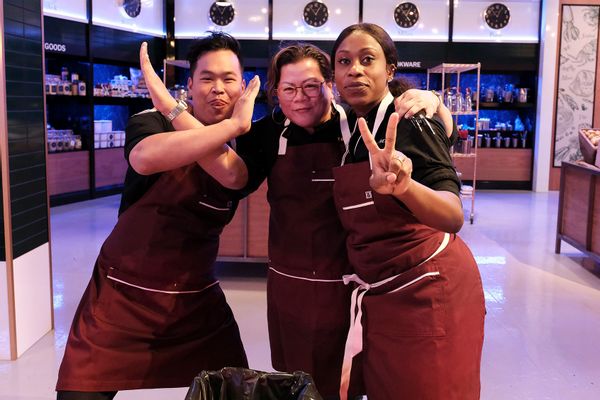 Buddha Lo, Nicole Gomes, and Victoire Gouloubi on "Top Chef" (David Moir/Bravo)
Buddha Lo, Nicole Gomes, and Victoire Gouloubi on "Top Chef" (David Moir/Bravo)
I also wanted to ask about the Quick Fire: How were those countries selected and how were those specific dishes picked? That was a really compelling challenge, as well.
Super fun! As as we mentioned, "Top Chef: World All Stars" was looking to have a global focused aspect to all challenges. We were in London, so we did lots of London-themed challenges, but we also wanted to embrace the global aspect since we were having chefs competing from all over the world, so that's how this idea came about.
Street food is common all around the world and there's all different types. So we just did our research, Googled what's the popular street food from certain countries and picked out the interesting ones. We had thought about maybe not including Canada or U.S. or food from any of the countries that our chefs are from, but then wound up including them to make sure we had a variety of different flavors and dishes represented, both sweet and savory.
It did also come down to what ingredients we were able to source because some dishes are very ingredient-specific, so if we can't get those ingredient, we may have to switch out for a different dish. So there's lots of researching and figuring this out . . . oh, maybe this dish isn't actually from this country originally. For example, it came up in the episode, when Amar was hoping for empanadas but they originated from Argentina, not the country he picked, Colombia. Sometimes where the dish actually originates from can vary depending on what you find on the internet, so that also helped dictate.
Want a daily wrap-up of all the news and commentary Salon has to offer? Subscribe to our morning newsletter, Crash Course.
Also connected to the Quick Fire, Charbel's response to failing to execute the Japanese dish takoyaki was good in that he didn't get down in the dumps about it, but still acknowledged that it was a dish he hadn't been aware of. I wondered if you thought that that may have then [adversely] affected how he fared in the elimination challenge?
I don't think so, necessarily. I think these chefs do take each challenge as it is. Typically the judges' requirement is on that dish of that challenge, so how he fared in the Quick Fire isn't taken into account for his elimination dish, so I don't think that affected him too much.
I have heard a lot of chefs in the past talk about when they go into Quick Fires, they're more fun and they don't have time to think, but also the stakes aren't as high — even though you do want immunity.
But I was kind of happy that that happened because that's what we sort of wanted to do because we didn't want all street foods that they all automatically knew or expected, like Nicole with the egg waffle. . . . It's part of the challenge and competition is taking something they don't know, and they also had a little description [of the dish] on the passport [they each received during the Quick Fire] so they can get a general idea of it.
"I have heard a lot of chefs in the past talk about when they go into Quick Fires, they're more fun and they don't have time to think, but also the stakes aren't as high — even though you do want immunity."
I think what you said about Quick Fires can also sometimes extend to "Last Chance Kitchen" as far as there isn't enough time to overthink, which is the opposite of the elimination challenge. In addition, I was also wondering about was the unique aspects of filming in London: grocery items, cultural influence, food and anything else that made it different from filming in Portland, LA or other former locations?
London can get a bad rap and when I first heard we were going to London, I thought ". . . really? Of all the food places?" But once you dig down and research, it's a very diverse culinary scene. Obviously Indian food is big there . . . you can find anything there. It's like NY or LA because you can pretty much get anything you need. Ingredients weren't that actually that hard to source as we thought might be the case. Whole Foods warned us that there might be some supply chain issues, but again, that's part of the challenge for the chefs, too. We have to see how they have to make it work with what you can [acquire] and work with what's available. [It's important that they can] pivot and that's how you show that you're the Top Chef! In order to see if you can make it work with whatever you have available.
But there are also some great markets, like Billingsgate Fish Market, where we were able to source the seafood from or from Borough Market, which had a lot of specialty stuff, as well. We've had tougher times in other places, I feel.
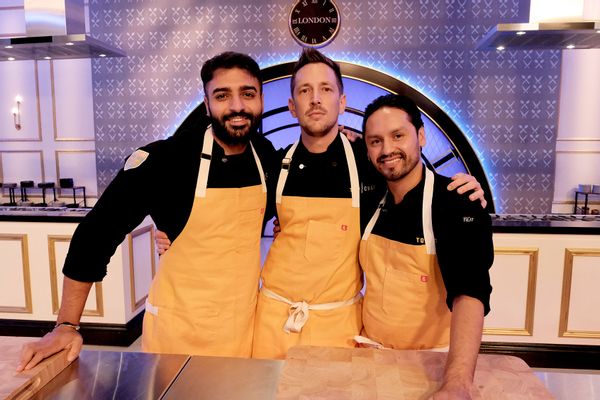 Ali Al Ghzawi, Tom Goetter, and Gabriel Rodriguez on "Top Chef" (David Moir/Bravo)
Ali Al Ghzawi, Tom Goetter, and Gabriel Rodriguez on "Top Chef" (David Moir/Bravo)
This connects back to the question about the crew during the mise race, but I was also wondering about the camaraderie aspect. We can see the cheftestants get along and make connections — obviously Ali and Amar is a big friendship we're seeing this year. On the back end or even for Tom, Padma and Gail, what's it like for people in production who have been working on the show for season after season?
Oh yeah, we're all a big family. We all keep coming back year after year because of the people we work with, love and hang out with. It's like TC summer camp because it happens three months per year and usually around the summer. We all call it "Top Chef" summer camp. We had a camp challenge in Season 17 and got camp shirts made for the whole crew. We have a great time out on the road, so yeah, it's a big family for sure.
"We had a camp challenge in season 17 and got camp shirts made for the whole crew."
Great! Have you been producing since Season 17?
Season 16, actually, in Kentucky, was my first season, but I've also [worked on] "Juniors" and "Family Style," too.
Ohh, cool, so you've seen Sara compete twice now?
Correct! Sara was on my first season and now she's back again.
Here's one that I think lots of people ponder: What happens to the leftovers, uneaten dishes, unused ingredients . . . where do they go?
That's the first question I'm usually asked: Do we get to eat the food? But unfortunately, we don't get to try the chef's food for fairness, we don't want to taint our opinions throughout the competition, so we don't get to eat what they make. But there are leftover ingredients and the pantry has to get turned over throughout [filming] to restock with fresher ingredients, so we typically do team up with local food banks to donate what we can and give away. Sometimes, the crew gets to take a little bit for themselves at night, so that's why I love when there's a local season when I'm in my apartment, so I can bring stuff home. It's hard to bring back [leftover] gumbo ingredients when you're not at home.
As far as this season versus others, how were the parameters of this season decided upon? The format seems in line with the U.S. "Top Chef" structure, but I wonder how the London filming location and international casting may have influenced that.
We followed the U.S. formatting because the show is airing in the U.S., and that's what our audience expects. It was interesting to find out the way things are run in other countries' ["Top Chef" competitions] since they're all a bit different. In France, they get hours for Quick Fires or other countries film three days a week or get to go home at night, but in this season, we followed the typical U.S. guidelines and rules throughout the competition.
"We followed the U.S. formatting because the show is airing in the U.S. and that's what our audience expects."
Do you have a favorite challenge you've worked on or favorite episode? Or is there any one challenge that comes to mind as being especially difficult?
There's been lots of difficult stuff, for sure. One of my fave challenges I always think back to was from Season 16 in Kentucky, the basketball challenge at the Rupp arena. I was in charge of getting those 2,000 to 3,000, however many fans we got to show up that day to come and fill up that stadium. We didn't even really know if people were coming or not really, but when all those people showed up, I was like: whoa. It was just a really cool feeling once we turned off the lights, had the chefs run out and the crew . . . I get chills now thinking about it. Such a cool experience that I wasn't even sure was going to happen, but it happened even better than what I was anticipating, so that's always been a cool and fun one for me.
It's always great when the chefs get to experience something unique, like in Italy, when they want to try the Culatello in Parma, that whole episode was a lot of fun. Or when they got to go to the Getty and look at art in a VIP tour in season 17. Any time you involve boats is a headache, but the crabbing episode in Portland was really fun to let them go out and do something like that.
Let me think if there's any others: Restaurant Wars is a very difficult one. It's such a challenge! That's the one we shoot over three days and not two, like the rest of the episodes. There's a lot more to it than just cooking and serving, but you probably also have to build a kitchen and get tables and chairs and flowers . . . the chefs want it to be perfect, so they're asking for a lot and we're trying to give them everything that we can that they would like. That's always a difficult one and at the end, there's a big sigh of relief.
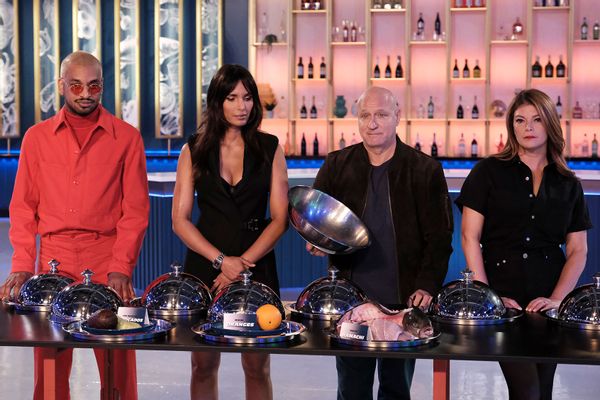 David Zilber, Padma Lakshmi, Tom Colicchio, and Gail Simmons on "Top Chef" (David Moir/Bravo)
David Zilber, Padma Lakshmi, Tom Colicchio, and Gail Simmons on "Top Chef" (David Moir/Bravo)
I would imagine! Would you say that the production team in general tends to prioritize and craft challenges in order to ensure especially difficult challenges, the best food or challenges that are bound to produce drama or "good tv"?
We definitely prioritize food. We want them to present good food, creative dishes, out of the box . . . that's definitely priority. The drama part naturally comes in, especially during a team challenge when fighting over budget. Maybe in a Quick Fire, we'll have more fun with the drama aspect of picking teams and stuff, but typically, first and foremost, we're thinking of what's the food challenge, what are they cooking, what are the dishes we're going to see . . . and then maybe we'll throw a twist on top of it after the fact.
The drama is — you can probably see as the show's evolved over the years, in the early seasons, it was very much villains and house reality drama and stuff, but we don't like to focus on that as much anymore. It's all about producing good food and showing off great talent with our chefs.
"It's all about producing good food and showing off great talent with our chefs."
There's definitely been a real shift in the culture of competitive reality TV in general and I think "Top Chef" is one of the shows that helped usher that that in, as far as not focusing on silly drama or arguments, but actually showcasing really high quality food, so that's always exciting to see.
That's one of the things that I love about working on the show is getting to the core of the cooking part of it, not [focusing on] having to be sneaky or something.
What would you love to see in the future and what would you like to see coming up next for "Top Chef"?
I do like these All Star seasons because they're fun, but more cool cities, more international travel for my personal wants . . . I like the All Stars stuff, but I also love bringing in new talent and showcasing them as well. I do love a twist, I hope that we can keep going with more twists and fun episodes. That's something else I loved about this episode as well: It's really fun, Quick Fire was fun and the elimination challenge was classic. I like the fast-paced stuff a bit better.
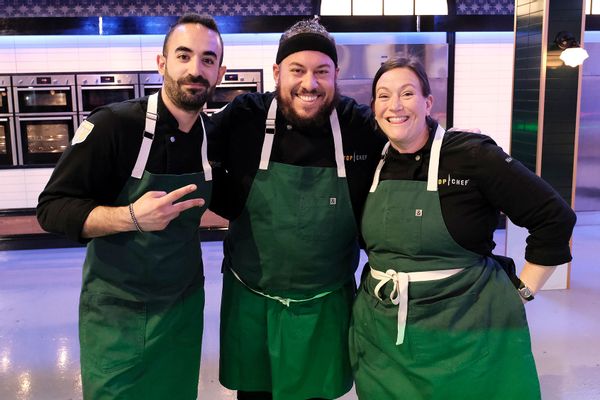 Charbel Hayek, Amar Santana, and Sara Bradley on "Top Chef" (David Moir/Bravo)
Charbel Hayek, Amar Santana, and Sara Bradley on "Top Chef" (David Moir/Bravo)
When it comes to replicating dishes at home, I know that Sara has been doing a lot of great stuff on her Instagram, sharing recipes and demos after episodes air.
That's been great to see. It's always fun to watch the chefs after on Instagram and to see chefs recreate their dishes. I also listened to the "Pack Your Knives" podcast, and Sara talks about how she adds dishes to her menu at her restaurant as the episodes come out.
Yes, I saw that! Such a great idea . . . I love it. Thank you. This has been super fun and informative and I really look forward to the rest of the season. I am a big Charbel fan, so I was bummed at the outcome of this episode, but we'll see what's coming.
There's still ["Last Chance Kitchen"]!
"Top Chef: World All Stars" airs Thursdays at 9 p.m. on Bravo and streams next day on Peacock.
Read more
about "Top Chef":


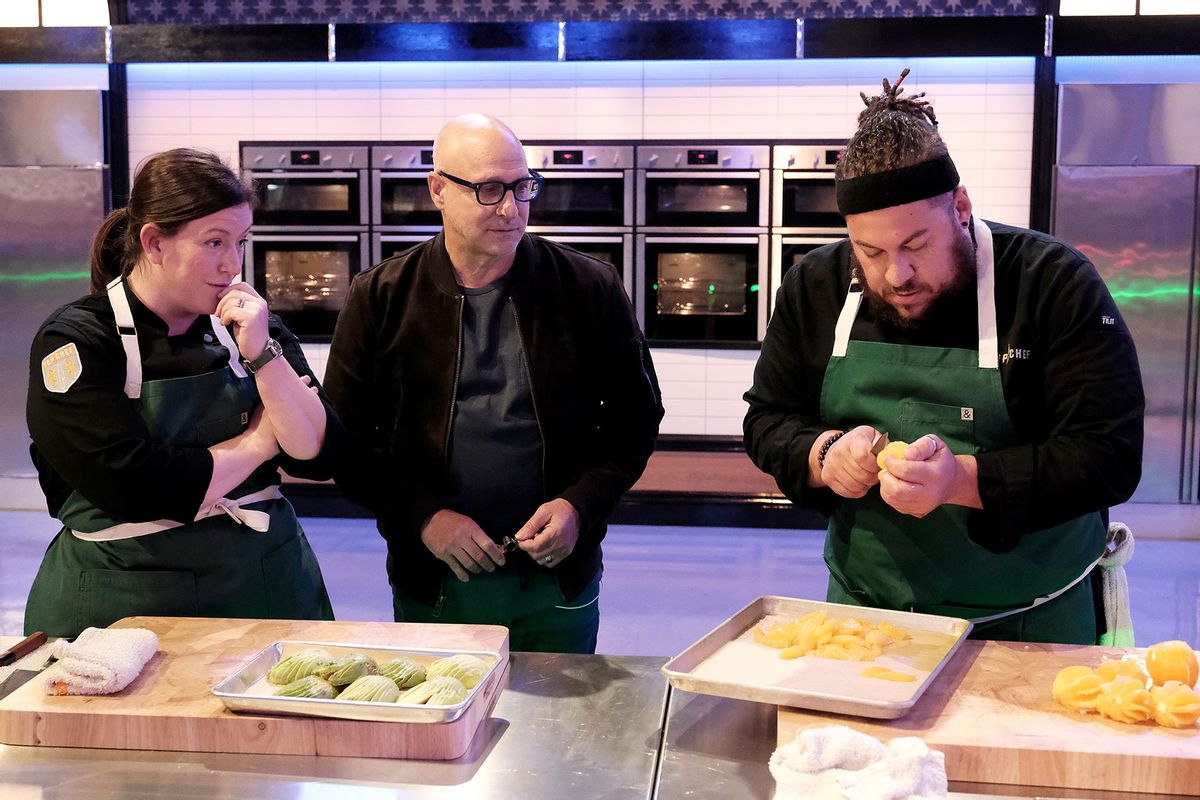
Shares